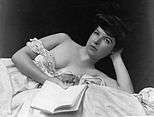Fitz W. Guerin

Fitz W. Guerin (March 17, 1846 – July 11, 1903)[1] was a recipient of the Medal of Honor in the American Civil War. On returning to civilian life, he became a successful society photographer in St. Louis, Missouri.
Early life
He was born in New York City, New York. At 13, he set out on his own and worked for the Merrill Drug Company in St. Louis and Western Union.[2]
American Civil War
He joined the Union Army as a teenager and served under Generals William Tecumseh Sherman, Nathaniel Lyon and Ulysses S. Grant. For his actions in conjunction with Sergeant Henry A. Hammel and Private Joseph Pesch on April 28 and 29, 1863, Private Guerin was awarded the Medal of Honor on March 10, 1896.[3]
Medal of Honor citation
The President of the United States of America, in the name of Congress, takes pleasure in presenting the Medal of Honor to Private Fitz W. Guerin, United States Army, for extraordinary heroism on April 28 & 29, 1863, while serving with Battery A, 1st Missouri Light Artillery, in action at Grand Gulf, Mississippi. With two comrades Private Guerin voluntarily took position on board the steamer Cheeseman, in charge of all the guns and ammunition of the battery, and remained in charge of the same for a considerable time while the steamer was unmanageable and subjected to a heavy fire from the enemy. General Orders: Date of Issue: March 10, 1896
Action Date: April 28 & 29, 1863
Service: Army
Rank: Private
Company: Battery A
Division: 1st Missouri Light Artillery[4][5]
Photography career
After the war, he returned to St. Louis and did menial jobs at a photographic gallery. He found better pay stringing telegraph wire for a railroad, but returned to photography, going into partnership and setting up Remington, Guerin, and Mills Gallery in Ottumwa, Iowa. He was eventually bought out and returned to St. Louis, where he worked for several established photographers, learning the trade.[2]
Finally, in 1876, he set up shop on his own. When he won an award at the 1878 Paris World's Fair,[6] he became an overnight success.[2] He established a reputation, received international recognition for his portraits, and was several times president of the National Photographic Society.[2][6] He opened several more galleries in the city, owning a total of six over his 27-year career.[6]
Pioneering women photographers Emme and Mayme Gerhard studied with him for three years.[7] When he retired in January 1903, he sold his studio to them.[6][8]
Guerin died of a heart attack on July 11, 1903.[6] He was buried at Bellefontaine Cemetery in St. Louis, the same resting place as his Medal of Honor co-recipients, Hammel and Pesch.
A 1982 American Heritage magazine article labeled him a "turbid Victorian hack", though it did concede he was technically gifted.[6] Some of his photographs are held by the Library of Congress.[9]
- Photographs by Fitz W. Guerin



References
- ↑ Fitz W. Guerin at Find a Grave
- 1 2 3 4 Dr. David S. Shields, McClintock Professor at the University of South Carolina. "Fitz W. Guerin". College of Arts and Sciences, University of South Carolina. Retrieved December 18, 2013.
- ↑ "Congressional Medal of Honor Awarded to Private Joseph Pesch". Missouri History Museum. Retrieved December 18, 2013.
- ↑ "Guerin, Fitz W.". Congressional Medal of Honor Society. Retrieved December 18, 2013.
- ↑ "Military Times Hall of Valor: Fitz W. Guerin". Military Times. Retrieved December 18, 2013.
- 1 2 3 4 5 6 Stephene Russell (March 2009). "Midwestern Fantasia: The Uncanny Photographs of Fitz W. Guerin". St. Louis Magazine. Retrieved December 18, 2013.
- ↑ "A Sisterly Profession". Library of Congress. November 2011. Retrieved December 18, 2013.
- ↑ "The Sisters Who Captured the World's Fair on Film". Missouri History Museum. April 12, 2013. Retrieved December 18, 2013.
- ↑ "5 results containing "Guerin, F. W. (Fitz W.), ..."". Library of Congress. Retrieved December 18, 2013.
External links
| Wikimedia Commons has media related to Fitz W. Guerin. |
- 1885 portrait of Guerin and two others, Missouri History Museum
- Midwestern Fantasia, a St. Louis Magazine article displaying six of his photographs